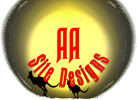Customising Your Web-Site
If you hire me to construct your web-site I will need some basic guidelines as to how you want it customised. These can be given before, during or after the content (information, pictures, animations, etc.) for the web-site has been entered into the web-site design program.This is the advantage of using theme based programs (such as Rapidweaver, Sandvox and iWeb). This means that the entire look and feel of a web-site can be entirely changed in minutes without changing the actual information within it. In addition each of these themes has many options that can be altered and styles that can be selected to further customise the look and feel of the web-site.
Navigation Menus
The navigation menus help people move from one page to the next. The are generally 4 basic locations for the navigation menu:- Horizontal Menu- Above Header Image
- Horizontal Menu - Below Header Image
- Vertical Menu - Left Side
- Vertical Menu - Right Side
- Pop-Up: These menus are hidden. To view them all that you have to do is move the mouse pointer over the parent menu icon. This will make the icons "pop-up" to the side of the selected parent menu icon so that they can be selected. Once this has been done they will again disappear.
- Indented: As soon as the parent menu icon has been selected these menu options appear (slightly indented) below it. These menu icons remain viewable until a different parent menu icon has been selected.
Logos
You should decide if and where you want your company logo displayed. If you want one and have not got one then you may want to look around for a good graphic designer to make you one.Fixed Or Variable Width Pages
Every computer screen has a maximum resolution. To make you web-site look its' best it should be of a width that is as big or smaller that the viewers current screen resolution. Finding out which resolution your viewers/customers use most can be done by adding code to each page that send these statistics (and others) back to a specific website, where you can access them.- Fixed Width: One of the main reasons for choosing a fixed width is so that the layout of your web-site will look as identical as possible on different computer systems and browsers (like a .pdf form). Some popular fixed widths include width 650px, 750px, 850px, 950px, 1050px.
- Variable Width: Using a variable with option allows you to have the information in your web-site format itself to the different screen widths that people use. Internet Exploer version 6 may have a problem with this option but most people do not use this anymore as it has lots of bugs.
Colours
If you are not satisfied with the default colours that your chosen them has then you are free to change them. Most themes offer the ability to change almost every color in the theme. Most themes offer specific colour styles. Each colour style has been designed to make sure that all the colours compliment each other.Fonts
You should decide what sort of fonts you want to use and what size they default font will be. Generally the size of the fonts gets smaller the less important it is. As a general guideline the sizes are as follows (largest to smallest):- Web-Site Title: generally 18+ pixels.
- Web-Site Slogan: about 18+ pixels.
- Web-Page heading: about 14-18 pixels.
- Paragraph heading: about 12-14 pixels.
- Normal text: about 10-12 pixels.
